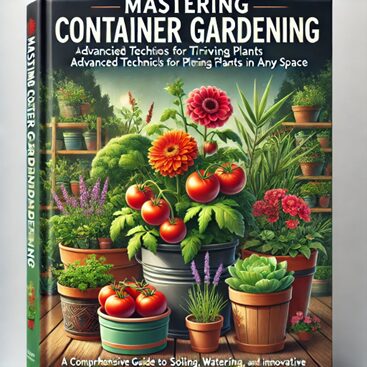Container Roses: 7 Proven Secrets for Amazing Growth!
Affiliate Disclaimer: This post contains affiliate links. If you purchase through these links, I may earn a small commission at no additional cost to you. This helps support the creation of more helpful content. Thank you for your support!
Discover the Power of Container Gardening
Are your dreams of a balcony bursting with beautiful blooms…
…ending with droopy, sad-looking twigs that mock your gardening aspirations? Fear not, fellow plant parent! You’re not alone in the quest for rose glory in a pot. Many have tried, and many have, well, composted their efforts.
But what if I told you there are actual, bona fide secrets to transforming your patio into a fragrant paradise, starring none other than thriving container roses? Forget ancient scrolls and mystical incantations; we’ve got 7 proven, down-to-earth (or rather, down-to-pot) secrets that will have your plants pumping out blooms like they’re getting paid for it. Get ready to unleash your inner rose whisperer!
In This Article
- Your Rose’s Royal Residence (It’s All About the Real Estate!)
- The Luscious Loam (Only the Best Dirt for Your Divas!)
- Sip, Sip, Hooray! (Quenching Thirst Without Drowning)
- Sun Worshippers (Give ‘Em a Tanning Bed, Not an Oven!)
- Feed Me, Seymour! (But, Like, Sensibly)
- The Glam Squad Makeover (Pruning for Perfection!)
- The Hibernation Hideaway (Tucking Your Roses in for Winter)
Secret #1: Your Rose’s Royal Residence (It’s All About the Real Estate!)
First things first, your container roses are a bit like tiny, thorny royalty – they have standards, darling. You can’t just shove them into any old plastic bucket you found behind the shed (unless it’s a fancy plastic bucket, maybe).
Pot Size Matters (No Tiny Apartments Here!)
Think penthouse suite, not a studio. Roses have surprisingly deep roots that like to stretch out. Aim for a pot that’s at least 15-20 inches wide and deep. Bigger is often better, giving your container roses more room to grow and insulating those precious roots from turning into baked potatoes on a hot Tennessee afternoon.
Drainage, Drainage, Did We Say Drainage?
If your pot doesn’t have drainage holes, it’s basically a flowery bathtub of doom. Roses hate soggy feet (it leads to root rot, the ultimate party pooper). Ensure there are plenty of holes for excess water to escape. Your plants will thank you with vibrant health, not a gurgling cry for help.
Material Girl (or Boy)
Terracotta is classic and breathes well but dries out fast. Plastic is lightweight but can get hot. Ceramic is pretty but heavy. Consider lighter-colored pots to keep roots cooler.
Picking Your Player
Not all roses dream of life in a pot. Look for varieties labeled as ‘patio roses,’ ‘miniature roses,’ ‘polyanthas,’ or smaller ‘shrub roses.’ These types are generally more compact and won’t try to take over your entire balcony in a single season. When selecting your container roses, check the tag for their mature size – it’s like a dating profile for plants, telling you if they’re a good long-term match for your pot.

Secret #2: The Luscious Loam (Only the Best Dirt for Your Divas!)
Alright, you’ve got the palace, now for the plush furnishings. Shoveling dirt from your backyard into a pot for your container roses is like serving royalty a microwave meal on a paper plate. Just… no. We’re aiming for a Michelin-star meal here, folks, not something you dug up next to where the dog does his business. Garden soil is too heavy, compacts easily, and might contain uninvited guests. Your delicate container roses deserve a high-quality, sterile potting mix. This isn’t just ‘dirt’; it’s a specially formulated blend designed for the unique demands of container life.
Secret #4: Sun Worshippers (Give ‘Em a Tanning Bed, Not an Oven!)
Your container roses are basically sun-chasing supermodels – they need their spotlight! For the best blooms and healthiest growth, they crave at least 6 to 8 hours of direct sunlight per day. However, their delicate root systems are more sensitive. Dark-colored pots can become miniature ovens, slow-cooking the roots. If your patio turns into a furnace, consider lighter-colored pots, grouping plants together for shade, or providing some afternoon shade with an umbrella.

Secret #5: Feed Me, Seymour! (But, Like, Sensibly)
Roses, especially those living the high-demand life in pots, are hungry little hippos. The nutrients in potting mix get depleted quickly. Begin fertilizing in early spring when new growth appears. Use a balanced rose fertilizer every 2-4 weeks. Don’t overdo it, and stop fertilizing about 6-8 weeks before your first expected frost to let them prepare for winter.
Secret #7: The Hibernation Hideaway (Tucking Your Roses in for Winter)
Your container roses are more vulnerable to the cold than their in-ground counterparts. A frozen pot can mean frozen (and very dead) roots. If possible, move your potted roses to a sheltered location like an unheated garage or shed once they go dormant. If you can’t move them, insulate the pots with bubble wrap or burlap. Check the soil moisture every few weeks and give them a little water only if temperatures are above freezing.

Unleash the Rose Titan Within!
So there you have it – your not-so-secret-anymore guide to cultivating container roses that will be the envy of your Pleasant View neighborhood. Growing stunning container roses isn’t about possessing some mythical ‘Green Thumb.’ It’s about understanding their needs, providing consistent care, and facing challenges with a smile. Go forth, armed with this wisdom, and transform your porch, patio, or balcony into your own personal fragrant haven.
At Last! How to Harvest an Abundance of Fresh Food Right on Your Patio
With Far Less Work Than Your Beautiful Container Roses
You, who pour care and attention into your stunning container roses, already understand the profound satisfaction that successful gardening brings. Now, imagine achieving that same level of reward – a continuous supply of fresh herbs, crisp vegetables, and juicy fruits – with a fraction of the effort. The Tower Garden 2 makes it a practical, year-round reality. It uses up to 90% less water, requires less space, and involves no soil, digging, or weeding. If the thought of fresh, pesticide-free, homegrown food greatly appeals to you, the Tower Garden 2 warrants your serious consideration.
Discover the Tower Garden 2

Leave a Reply